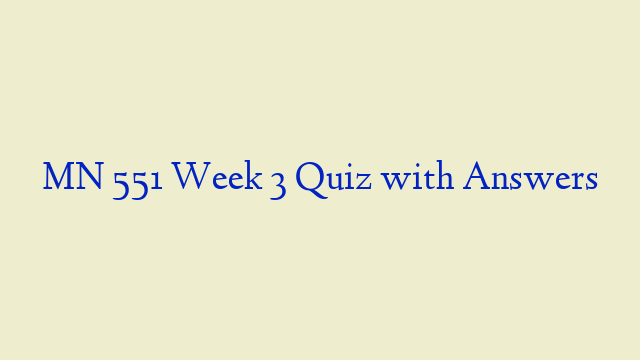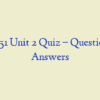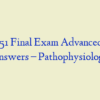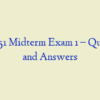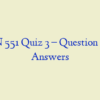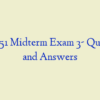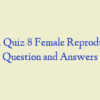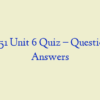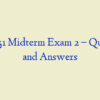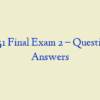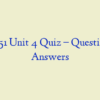Description
MN 551 Week 3 Quiz (Question and Answers)
- A patient is experiencing impaired circulation secondary to increased systemic arterial pressure. Which of the following statements is the most relevant phenomenon?
- A 54-year-old man with a long-standing diagnosis of essential hypertension is meeting with his nurse practitioner. The patient’s nurse practitioner would anticipate that which of the following phenomena is most likely occurring?
- A patient in the intensive care unit has a blood pressure of 87/39 and has warm, flushed skin accompanying his sudden decline in level of consciousness. The patient also has arterial and venous dilation and a decrease in systemic vascular resistance. What is this patient’s most likely diagnosis?
- A 55-year-old male who is beginning to take a statin drug for his hypercholesterolemia is discussing cholesterol and its role in health and illness with his nurse practitioner. Which of the following aspects of hyperlipidemia would the nurse practitioner most likely take into account when teaching the patient?
- Which of the following assessment findings in a newly admitted 30-year-old male patient would be most likely to cause his nurse practitioner to suspect polyarteritis nodosa?
- In which of the following patient situations would a nurse practitioner be most justified in preliminarily ruling out pericarditis as a contributing pathology to the patient’s health problems?
- A nurse practitioner has ordered the measurement of a cardiac patient’s electrolyte levels as part of the patient’s morning blood work. Which of the following statements best captures the importance of potassium in the normal electrical function of the patient’s heart?
- As part of the diagnostic workup for a male patient with a complex history of cardiovascular disease, the care team has identified the need for a record of the electrical activity of his heart, insight into the metabolism of his myocardium, and physical measurements, and imaging of his heart. Which of the following series of tests is most likely to provide the needed data for his diagnosis and care?
- A patient has suffered damage to his pericardium following a motor vehicle accident. Which of the following consequences should the nurse practitioner be most likely to rule out?
- An older adult female patient has presented with a new onset of shortness of breath, and the patient’s nurse practitioner has ordered measurement of her BNP levels along with other diagnostic tests. What is the most accurate rationale for the nurse practitioner’s choice of blood work?
- A 31-year-old woman with a congenital heart defect reports episodes of lightheadedness and syncope, with occasional palpitations. A resting electrocardiogram reveals sinus bradycardia and she is suspected of having sick sinus syndrome. Which of the following diagnostic methods is the best choice to investigate the suspicion?
- The nurse practitioner for a cardiology practice is responsible for providing presurgical teaching for patients who are about to undergo a coronary artery bypass graft. Which of the following teaching points best conveys an aspect of the human circulatory system?
- A 72-year-old woman with a recent onset of syncopal episodes has been referred to a cardiology group by her family physician. As part of the patient’s diagnostic workup, the nurse practitioner conducting the intake assessment has ordered a Holter monitor for 24 hours. Which of the following statements best captures an aspect of Holter monitoring?
- A number of patients have presented to the emergency department in the last 24 hours with complaints that are preliminarily indicative of myocardial infarction. Which of the following patients is least likely to have an ST-segment myocardial infarction (STEMI)?
- A 68-year-old male complains to his nurse practitioner that when he tests his blood pressure using a machine at his pharmacy, his heart rate is nearly always very low. At other times, he feels that his heart is racing, and it also seems to pause at times. The man has also occasionally had lightheadedness and a recent syncopal episode. What is this patient’s most likely diagnosis and the phenomenon underlying it?
- An autopsy is being performed on a 44-year-old female who died unexpectedly of heart failure. Which of the following components of the pathologist’s report is most suggestive of a possible history of poorly controlled blood pressure?
- An 81-year-old male resident of a long-term care facility has a long-standing diagnosis of heart failure. Which of the following short-term and longer-term compensatory mechanisms is least likely to decrease the symptoms of his heart failure?
- A 66-year-old patient’s echocardiogram reveals a hypertrophied left ventricle, normal chamber volume, and a normal ejection fraction from the heart. What is this patient’s most likely diagnosis?
- A 22-year-old male is experiencing hypovolemic shock following a fight in which his carotid artery was cut with a broken bottle. What immediate treatments are likely to most benefit the man?
- An 81-year-old female patient of a long-term care facility has a history of congestive heart failure. The nurse practitioner caring for the patient has positioned her sitting up at an angle in bed and is observing her jugular venous distention. Why is jugular venous distention a useful indicator for the assessment of the patient’s condition?
- A nurse practitioner is instructing a group of older adults about the risks associated with high cholesterol. Which of the following teaching points should the participants try to integrate into their lifestyle after the teaching session?
- Which of the following situations related to the transition from fetal to perinatal circulation would be most likely to necessitate medical intervention?
- A 66-year-old obese man with a diagnosis of ischemic heart disease has been diagnosed with heart failure that his care team has characterized as attributable to systolic dysfunction. Which of the following assessment findings is inconsistent with his diagnosis?
- During a routine physical examination of a 66-year-old woman, her nurse practitioner notes a pulsating abdominal mass and refers the woman for further treatment. The nurse practitioner is explaining the diagnosis to the patient, who is unfamiliar with aneurysms. Which of the following aspects of the pathophysiology of aneurysms would underlie the explanation the nurse provides?
- A nurse practitioner is teaching a student NP about the physiologic basis for damage to the circulatory and neurological systems that can accompany hypotension. Which of the following responses by the student would warrant correction by the nurse practitioner?
